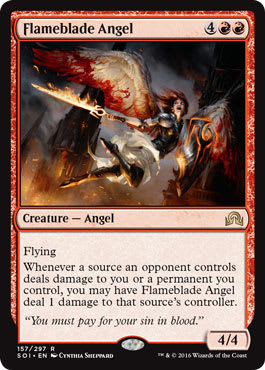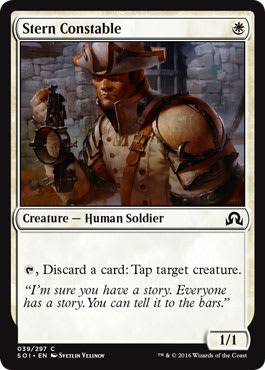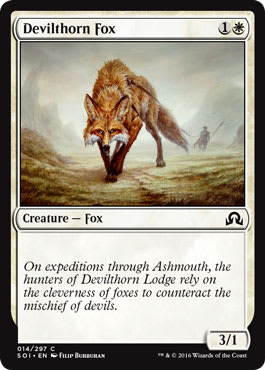In the nearly eight-year history of the Intro Pack, which replaced the Theme Deck beginning with Shards of Alara, we’ve seen some very impressive decks.
But just as with any other product, quality and mileage may vary. Today’s deck will never be confused for one belonging amongst the august company of the product line’s best. To be blunt, it’s not very good.
Let’s start with the name. While there have been a few clunkers in the naming department over the years, such as Odyssey’s Trounce-O-Matic or Mirrodin’s Wicked Big (which never fails to invoke a Massachusetts accent in my mind), names aren’t something we focus on for critical appraisal. But it’s fair to say that if you purchase a Magic deck called Angelic Fury, you might expect it might contain more than one Angel—and some of their fury.
Instead, you get a flashy, premium rare Angel . . . and that’s it. What makes the rest of the deck angelically furious? Start cracking Cluestones—because I for one have no idea.
The greater sin, perhaps, isn’t that this seems to indicate a theme that isn’t present, but rather that the deck has very little in the way of theme at all. This makes it the set’s odd deck out. Vampiric Thirst, which we meddled with last week, is a mix of tribal Vampires and madness. Unearthed Secrets plays with investigate and clue tokens. Ghostly Tide blends Spirits and flying. Horrific Visions answers Iron Maiden’s longstanding question by showing that, yes, you can indeed play with madness.
But Angelic Fury? To paraphrase a Rosewaterism, the lack of a theme is not a theme. Instead, this is more just a collection of cards.
That doesn’t mean, however, that we throw it in the bin and start from scratch. By Jove, to each Intro Pack a Meddling, and a Meddling to each Intro Pack!
For those just joining us, Meddlings are a feature where we take an Intro Pack deck and tune it, following two golden rules that help keep it accessible and affordable. The idea is not to build a deck that is going to shake the foundation of the world, but rather to highlight deck-building principles as we look to reinforce a deck’s aims and themes. Even if, as today, it’s just a collection of cards.
Golden Rule Number One: We can only draw upon cards from sets that are present within the stock deck. So for today, that means Shadows of Innistrad only.
Golden Rule Number Two: We can only add in uncommons and commons.
Let’s begin with a look at the stock deck list itself.
Angelic Fury ? Intro Pack | Wizards of the Coast
- Creatures (19)
- 1 Flameblade Angel
- 1 Unruly Mob
- 2 Ember-Eye Wolf
- 2 Howlpack Wolf
- 2 Inspiring Captain
- 2 Pyre Hound
- 2 Stern Constable
- 3 Cathar's Companion
- 3 Devilthorn Fox
- 1 Runaway Carriage
Slimming Down
Our stock deck has a lot of visible fat to trim, and we’ll need to wield a ruthless scalpel to clear out some space. Intro Packs always want to expose players to a wide variety of cards, which makes for great sampling but not very consistent play. Sometimes, inconsistent play is a delight, such as with Duel Decks and Commander. For our purposes, though, it’s a force we’ll want to minimize, and we do that by hewing closer to the classic “rule of nine” deck-building maxim: four copies of nine different cards plus twenty-four lands.
If we’re to construct a nicely aggressive Boros deck from Angelic Fury, we need to cut out anything that doesn’t fit that objective. First up is the Stern Constable. The Constable really highlights the what-is-this-deck-doing?-ness of Angelic Fury. As a 1/1 for 1 mana, it lets you throw away a card for a relatively minor effect that isn’t even repeatable (he taps as part of the cost). Now, in a deck built around madness, you can look to not only mitigate, but to take advantage of that steep activation cost as a nice discard outlet. Angelic Fury isn’t that deck. This isn’t a one-off, as the deck also carries a Murderer's Axe and a Lightning Axe, both of which are hungry for perfectly good cards. Not only does the stock list fail to carry a single card with madness, but the cleverest it gets here is a miser’s copy of Gryff's Boon. Sorry, Constable, but there’s nothing to see here. Move along.
On to the Ember-Eye Wolf, a 2-drop 1/2. Although haste is always nice, as is being able to sink excess mana into it through pumping, it’s just not robust enough for us to keep. The problem is that 1 power—you’re basically having to pay mana to make it any good. That might be fine on turn seven, when you’re looking for places to blow some extra mana, but not so ideal on the turns leading up to that—turns that are critical for our deck’s development.
Next out is the Unruly Mob. The Mob isn’t a bad card, and in the right deck (a sacrifice-based one), it can realize its full potential. The problem here is that it’s weak when first played as a 1/1, and it only achieves the level of power you’d expect for a 2-mana creature in white once something’s died. But even then, we wouldn’t run Grizzly Bears here—they just don’t do enough. So to begin to be appealing, we need to wait for two creatures to die, making the Mob a 3/3. That isn’t always going to reliably happen on the timetable of our liking, and it puts some measure of control over the card’s power into our opponent’s hands.
That leads us to the Howlpack Wolf. On the face of it, this one’s a little puzzling, too. Since a 3/3 for 3 mana for red here at common is perhaps a little too strong (red is not a creature efficiency color), there’s a blocking restriction on the Wolf. Ah, but that must mean the deck has a number of other Wolves to synergize together, right? Well, not really. You have more Hounds and Foxes here than you have more Wolves, with only two copies of the Ember-Eye Wolf to lift the restriction. The Howlpack Wolf is only here because it’s still relatively efficient, but as you’ll soon see, we’ll be cutting it in favor of something that’s more efficient still.
That’s a similar problem for the Pyre Hound. While it’s nice to see another red, spell-loving creature a la Kiln Fiend, that more properly belongs in one of the U/R, spell-heavy constructions to get the most out of it. As is, it lacks the efficiency to be attractive to this deck, and like the Unruly Mob, it’s not as attractive outside of its desired environment.
Finally, there’s the Runaway Carriage, a rather odd member of the family of cards inspired by the original Ball Lightning. Typically with cards like these, you see lopsided power-and-toughness stats in favor of the former. That makes sense—since they’re dying at the end of turn anyway, they have less use for durability than their more persistent compatriots. Here, however, the Carriage actually has a higher toughness. All the same, it’s not the direction we’ll want to go with our more expensive cards. We’ll let the Carriage give the Inspiring Captain a ride home—his services won’t be needed either, for much the same reason.
Building Time
With most of the deck gutted, what are we keeping? It’s not an easy question—this deck’s theme is so faint that it’s difficult to rebuild other than just “Boros beaters.” Still, we want to at least keep it somewhat recognizable to the original.
The means the Devilthorn Foxes are in. 2-mana 3/1s are a somewhat modern design in Magic, having first appeared in Future Sight as the Blade of the Sixth Pride. We’ve seen a handful since (most recently with the Kor Castigator in Battle for Zendikar), and it’s always a nice, aggressive inclusion. Sure, the backend is a bit brittle, and they’ll trade with just about anything, but the idea is that they’ll help apply some offensive bite early and can continue to profitably attack even after regular-sized creatures (2/2s) have been eclipsed.
We’ll also be going to four copies of the Cathar's Companion. Another 3/1 in white, this one gives us the prospect of combat trickery and one-sided combat.
Finally, we’ll be retaining the services of the Flameblade Angel. The Angel will serve as a closing option, one that gives us a bit of reach across the battlefield. That’s not just because she’s evasive. Rather, even with a few tricks on our side with a few of our creatures, we’ll still be looking to do a lot of our damage early before our smaller creatures become outclassed by our opponent. The Angel is a hedge, a way to finish off the opponent with an alpha strike of smaller creatures regardless of whether our opponent blocks—for each one the opponent blocks, the player will still be taking a point of damage off the Flameblade Angel. To make that feasible, however, we’ll need to be sure we’re getting in some early damage.
Let’s now round out our creature complement with some new faces, to ensure we can. First up is the Insolent Neonate. We ran four of these in last week’s madness/Vampires deck, and it servers much the same role here. Thanks to menace, it’s a tougher block, meaning it’s more likely to sneak in some early damage at the start of the game. It can cycle itself from the battlefield, letting us draw a new card to replace it once it’s no longer serving good purpose. Finally, it’s a discard outset for madness. While we won’t be building a deck around that mechanic, a splash of it is surely in order.
Next is a set of Kessig Forgemasters. A double-faced Werewolf, since we’re not building around the creature type, we want to be sure the untransformed creature is worth the inclusion. Here, we have essentially a Goblin Piker with a bonus, which is to ping anything blocking it for a point of damage. This is useful, ensuring we don’t lose our Forgemaster in a bad trade with some random 1/1—the Forgemaster’s ping will kill a 1/1 blocker before damage is assigned. That also means the Forgemaster can trade with anything with 3 toughness. All in all, that’s a solid 2-drop, and if we are able to keep it transformed into the Flameheart Werewolf, so much the better.
Speaking of Werewolves, we’ll also want to add a play set of the Breakneck Rider. This is the card that jockeyed for position with the Howlpack Wolf. While the Wolf is a 3-mana 3/3 with a modest downside, the Rider is a 3-mana 3/3 with upside: the ability to become a solid body with a buff for the team. The only drawback is that the Rider is slightly harder to cast (you need an extra ![]() ), but that’s easily worth the tradeoff here.
), but that’s easily worth the tradeoff here.
Last, we’ll want a play set of the Bloodmad Vampire. She takes the lopsided, offensive statting of our Foxes and Hounds and cranks it up an extra notch. She also has the ability to come out 1 mana cheaper thanks to madness, and to grow larger each time she connects with our opponent. Not a bad package!
Supporting Act
The noncreature suite of cards in the stock Angelic Fury is all over the place. It boasts the usual scattershot removal package, the Murderer's Axe we discussed above, and more odds and ends that culminates in the deck’s second rare, Devils' Playground. Devils' Playground is rather expensive at 6 mana, but creating four 1/1 dorks that do a point of damage on death can at least push through an extra bit of damage at the end of the game.
Because we’re focusing on a creature-based attack, with a focus on the 2- and 3-drops, we’ll want to be sure to have a decent removal package to keep the attack lanes open for business. Our opponent is going to happily throw whatever the player can in our path, and there’s not a lot of synergy between available cards here that lets us do much more than keep pace in the early- to midgame.
The first thing up is a play set of Fiery Temper. We don’t want to go too deeply into madness territory, but we won’t feel terrible about paying full cost for these if we have to. There are enough discard outlets here, though, to make it a safe inclusion, and it’s hard to overlook a Lightning Bolt in an environment with largely mediocre removal.
Four of those discard outlets are Lightning Axes. With eight cards in the deck that have a madness discount, we should have little problem sending the Axe out on the cheap, and in a pinch, we can make do with an extra land later in the game. A combo of Lightning Axe and Fiery Temper is a one-two punch that should hammer an opponent’s defenses and keep up our ability to profitably attack. There may be times when the correct aggressive play is to throw away a perfectly good card to the Axe to get the burn going, but recall the stock Angelic Fury deck—with its Stern Constables and Murderer's Axe—asked you to do the same for even less of a return. Don’t be afraid to trade a little long-term advantage for shorter-term gain if advantage is there for the taking.
Our final spell here is a bit of a fun one: three Skin Invasions. This Aura serves two purposes. First, by compelling an opponent’s creature to attack turn after turn, we get away from having to deal with it as a blocker. That’s a tradeoff we’re delighted to make, and you always want to regard your life total as just another resource to be spent on the way to victory. Second, it adds a nice, solid, 3/4 body to our side of the table when it ultimately dies, deepening our offensive makeup. Alternately, we can enchant our own creature instead, making an attacker that our opponent may be reluctant to kill. A 1-mana 3/4 is a tempting value either way, though we do run the risk of being two-for-one’d if our opponent is holding instant-speed removal and snuffs out our creature in response.
Here’s the completed list.
Meddled Angelic Fury ? Intro Pack | Jay Kirkman
- Creatures (24)
- 1 Flameblade Angel
- 3 Kessig Forgemaster
- 4 Bloodmad Vampire
- 4 Breakneck Rider
- 4 Cathar's Companion
- 4 Devilthorn Fox
- 4 Insolent Neonate
- Spells (12)
- 1 Devils' Playground
- 4 Fiery Temper
- 4 Lightning Axe
- 3 Skin Invasion
- Lands (24)
- 14 Mountain
- 6 Plains
- 4 Stone Quarry
Angelic Fury is among the least impressive Intro Packs that come to memory, and the lack of a core identity is rather surprising. Although, given the cards we have, it still feels a little light on the identity aspect, we did end up with something substantially more playable than the stock Intro Pack deck.
Given how open this Meddling was, I’d be interested in hearing your thoughts and ideas—especially if you want to take it in a different direction and build something different. Given the card pool and lack of concrete focus, what would you have come up with? Let me know in the comments below, and let’s keep the discussion going!


























